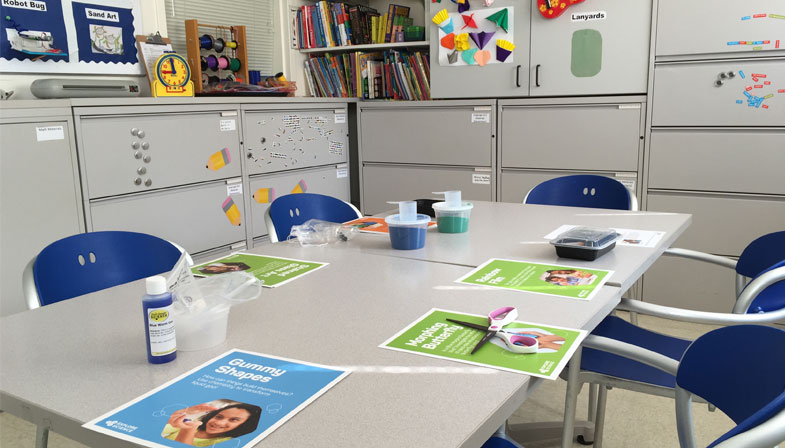 Before arriving at the children’s hospital, you’ll need to prepare hands-on science for two main venues: the classroom and the bedside (Although I have considered the waiting room a possibility, it is a busy space and may not be suitable for hands-on science as you’re competing with staff for parents attention, creating sound, and other distractions that may negatively impact the hospital’s performance.). The basic difference between the bedside and classroom is simple. With the classroom, kids come to you and for bedsides, you go to them. Each have their own challenges. This post will talk about the challenges and advantages of presenting hands-on science in the hospital classroom.
Before arriving at the children’s hospital, you’ll need to prepare hands-on science for two main venues: the classroom and the bedside (Although I have considered the waiting room a possibility, it is a busy space and may not be suitable for hands-on science as you’re competing with staff for parents attention, creating sound, and other distractions that may negatively impact the hospital’s performance.). The basic difference between the bedside and classroom is simple. With the classroom, kids come to you and for bedsides, you go to them. Each have their own challenges. This post will talk about the challenges and advantages of presenting hands-on science in the hospital classroom.
Of besides and classroom, providing hands-on science in the classroom has several advantages:
- *Supplies should be readily available.
- *There should be plenty of room for most table-top activities.
- *You can engage multiple kids at the same time, put them on separate projects, and/or have them help each other.
- *You have a bit more leeway in terms of selecting materials in regards to disposability and sanitation.
- *You can engage kids with projects that require more time.
Time is a double edge sword, though, and the biggest challenge. Kids can be in the classroom for about 2 hours, and you’ll need enough learning material to keep them engaged for that long. As someone who has clocked plenty of time on the museum floor doing table-top demos, this is a big challenge because most activities I have experience with (and can be found here on howtosmile) are designed for brief encounters that last, at most, for five to ten minutes. The basic solution to this problem for informal science educators is quantity: bring a lot of activities. But quantity can be burdensome. Realistically, you need to be creative in extending your demos: for example, if you have any draw-able surfaces and the material is disposable yet safe enough for the kids to take, modify your activity into a make and take. I did this with the Exploratorium’s Remote-Control Roller. Instead of an aluminium can, I taped together two styrofoam cups that the kids drew on. Or, turn the activity into experimenting with variables. What if you taped the styrofoam cups differently? What if you taped some aluminum foil to the inside or the outside? Who can get their cups to dance the most? With practice, you will be able to extend and improve the quality of your demos.
The other big challenge for the classroom is the wide range of learning skills and interests. You can have a 6 year old next to a 13 year old, and you’ll need to keep both of them engaged. Even among kids the same age, there can be vast differences in ability. You need to be prepared to explain things differently, provide different levels of assistance, and maybe, provide wholly different activities. And this is familiar to any docent/explainer on a museum floor with some exceptions: You have a captive audience in the classroom (unlike visitors to the museum who can decide to skip your activity), and unlike the bundles energy we experience visiting our museum, most kids at the hospital are low-energy due to illness. Luckily, most classrooms, like the one at Children’s Hospital Oakland, have extra activities lying around, but more importantly, the classroom has a great, dedicated staff and volunteers to help you! Communicate your needs, and delegate if need be. And it doesn’t hurt to bring in chocolates or homemade desserts for the staff and volunteers.
Check out blog #3 in this series: Doing Science at the Bedside (Part 1)
